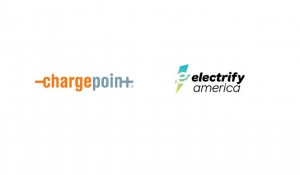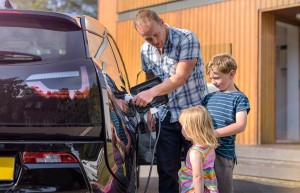
ChargePoint and Electrify America are partnering to allow users of their charging networks to use both now at no additional cost.
Imagine trying to travel if you could only fill up your tank on one brand of gasoline – or had to pay a stiff premium if you pulled into some other brand’s station. That has been more the norm than the exception for EV owners, another reason why some potential buyers have been reluctant to plug in.
Now, however, the various charging companies that will depend on building up a market are starting to team up. Electrify America and ChargePoint today announced a roaming partnership that will let their customers plug in at each other’s stations and not have to pay additional fees or set up separate accounts.
The move could mean substantial savings while also making it easier to find a place to plug in. Together, the two companies already operate more than 30,000 Level 2 and Level 3 quick chargers across the U.S., with thousands more expected to open in just the next year.
“This roaming agreement further accelerates the seamless integration of individual EV fueling networks and brings us even closer to the day when the movement of all goods and people will be powered by electricity,” said Pasquale Romano, president and CEO, ChargePoint Inc.
(Electrify America puts in EV chargers at Walmarts. Click Here for the story.)
“By connecting our public charging networks, we increase the convenience and accessibility EV drivers need to travel where they want, when they want,” added Giovanni Palazzo, president and CEO of Electrify America.
Sales of electrified vehicles still remain a niche in the U.S. market, but demand for plug-based models, pure battery-electric vehicles, in particular, has grown sharply during the last 18 months. And it’s expected to show an even greater surge as more long-range offerings, such as the new Audi e-tron, Jaguar I-Pace and Kia Niro come to market.
Still there is the chicken-and-egg problem to address. While most owners are expected to charge their vehicles at home 80% of the time, the lack of robust public charging network has limited the ability to use plug-based products to travel as freely as motorists can with gas- and diesel-powered vehicles.
The networks are expanding, however. Electrify America, which is funded by $2 billion from the Volkswagen diesel emissions settlement, plans to add hundreds more during the next several months. And ChargePoint and other competitors, such as EVgo, are also launching new stations on an almost daily basis.
But motorists have often found themselves facing an unpleasant surprise when they reach a station that’s not part of their regular network. Among other things, they have faced access fees that can run $5 or more, as well as higher prices for the energy they purchase.
The partnership between ChargePoint and Electrify America means their customers will be able to plug in at stations operated by either company without those added costs.
(Click Here for more about Electrify America’s plans.)
Such “interoperability” agreements are becoming more common. ChargePoint announced one such deal with several competitors in November 2017, while Electrify America revealed a similar approach with EV Connect, Greenlots and SemaConnect last October.
Charging in public still has its challenges. The majority of the stations now open are concentrated in places like Los Angeles, San Francisco and the New York area where EV sales have been strongest. But Electrify America, for one, has begun targeting middle-American regions, recently setting up several stations on Interstate 80 where it runs through Ohio. And it is teaming up with Walmart to place hundreds of chargers at heartland store locations.
ChargePoint has also begun rolling out facilities in less EV-dense regions. Still, it could be years before motorists would find the U.S. network as robust as the current gas station infrastructure.
There’s also the issue of incompatible charger plugs. The large Tesla Supercharger network uses a unique plug that can’t be shared with other manufacturers’ models. Tesla does provide an adaptor for Models S and X owners to use chargers operated by companies like ChargePoint, EVgo and Electrify America, but not for the high-volume Model 3 sedan. Most other models use a common plug known as the CCS but Nissan vehicles only can plug into chargers using the CHAdeMO standard.
Most public – non-Tesla – stations use the CCS plugs and typically offer at least one charger with a CHAdeMO plug, as well. That latter standard could wind up being phased out, however, if for no other reason than it is limited in how much power it can handle, typically no more than 50 kilowatts.
(To see more about the nationwide charging system falling into place, Click Here.)
Most of the new, Level 3 chargers going into public stations are being powered up to 150 and even 350 kilowatts. The high figure will be able to boost an EVs range by as much as 20 miles a minute, or nearly as fast as a gas-powered vehicle can fill up.

